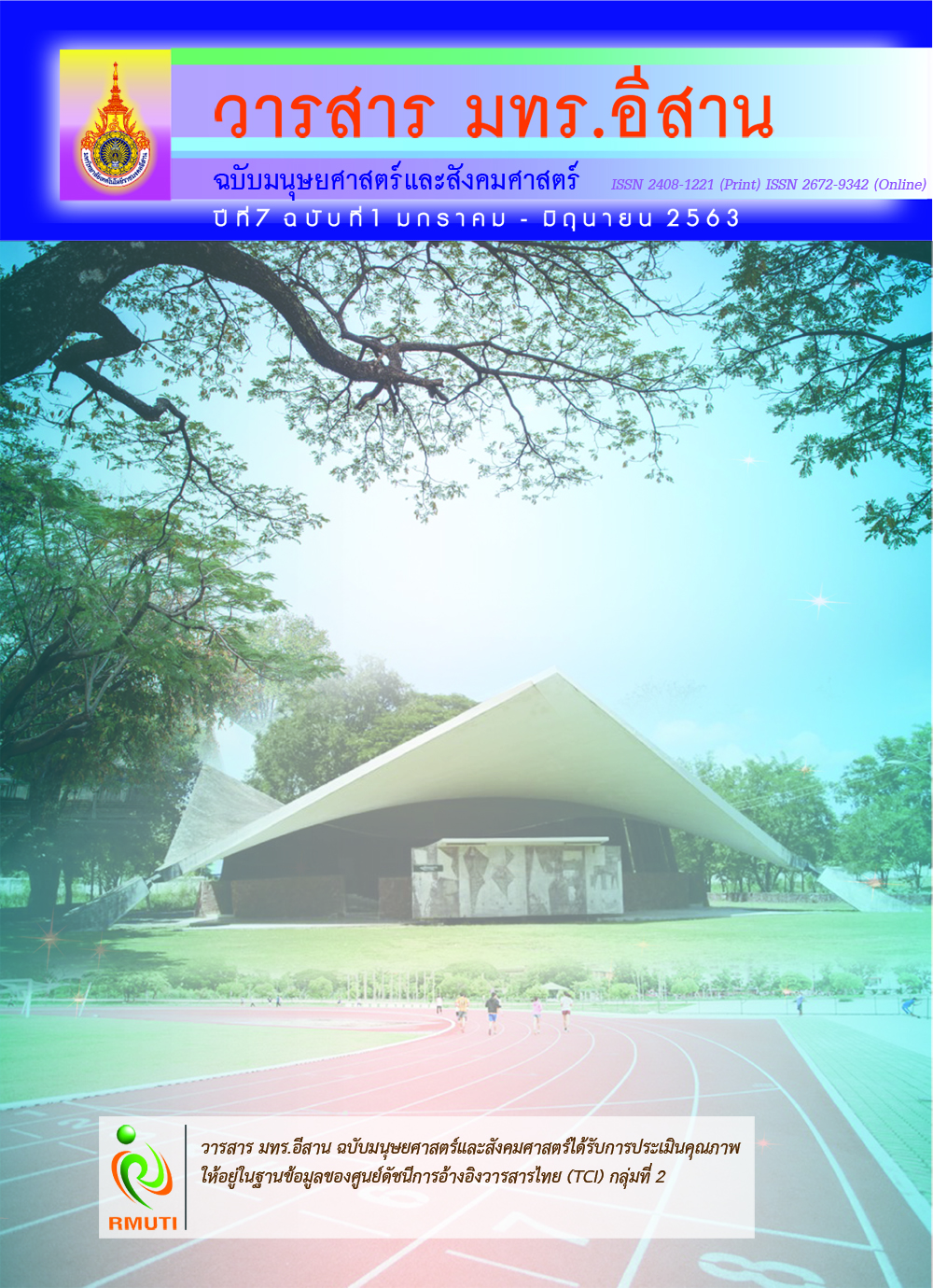Relationship between Quality of Work Life and Organizational Commitment of Lecturers at a Private University: A Canonical Correlation Analysis
Main Article Content
Abstract
This study aimed 1) to investigate quality of work life, 2) to study organizational commitment and 3) to figure out the relationship between quality of work life and organizational commitment. The samples consisted of 155 lecturers at a private university, and the data were analyzed using statistics, namely percentage, means, standard deviation and canonical correlation analysis. The results indicated that in respect of canonical correlation between quality of work life and organizational commitment, the canonical correlation coefficient for the first function was 0.857, which showed the highest level of relationship between the variables. In particular, constitutional organization in quality of work life and affective commitment in organizational commitment had the highest canonical loading at (-0.736) and (-0.821) respectively. It indicated the strong relationship between quality of work life and affective commitment. Therefore, the organization should emphasize lecturers’ quality of work life in order to reduce their turnover. The organization should enhance the lecturers’ satisfaction toward organizational commitment and royalty in the future.
Article Details
บทความที่ได้รับการตีพิมพ์เป็นลิขสิทธิ์ของมหาวิทยาลัยเทคโนโลยีราชมงคลอีสาน
ข้อความที่ปรากฏในบทความแต่ละเรื่องในวารสารวิชาการเล่มนี้เป็นความคิดเห็นส่วนตัวของผู้เขียนแต่ละท่านไม่เกี่ยวข้องกับมหาวิทยาลัยเทคโนโลยีราชมงคลอีสานและคณาจารย์ท่านอื่นๆในมหาวิทยาลัยฯ แต่อย่างใด ความรับผิดชอบองค์ประกอบทั้งหมดของบทความแต่ละเรื่องเป็นของผู้เขียนแต่ละท่าน หากมีความผิดพลาดใดๆ ผู้เขียนแต่ละท่านจะรับผิดชอบบทความของตนเองแต่ผู้เดียว
References
ติน ปรัชญพฤทธิ์. (2550). สภาพแวดล้อมการบริหารกับการพัฒนาองค์การ. ใน เอกสารการสอนชุดหน่วยที่ 1-7 หน้า 12-45. นนทบุรี: มหาวิทยาลัยสุโขทัยธรรมาธิราช
ธีรวุฒิ เอกะกุล. (2543). ระเบียบวิธีวิจัยทางพฤติกรรมศาสตร์และสังคมศาสตร์. อุบลราชธานี: สถาบันราชภัฎอุบลราชธานี
นงลักษณ์ วิรัชชัย. (2553). ชุดวิชาการวิจัยหลักสูตรและการเรียนการสอน หน่วยที่ 7 การศึกษาวรรณกรรมที่เกี่ยวข้องและหน่วยที่ 10 สถิติวิเคราะห์เชิงปริมาณ: สถิติบรรยายและสถิติพาราเมตริก หลักสูตรปริญญาศึกษาศาสตร์มหาบัณฑิต สาขาหลักสูตรและการสอนมหาวิทยาลัยสุโขทัยธรรมาธิราช. กรุงเทพมหานคร: โรงพิมพ์มหาวิทยาลัยสุโขทัยธรรมาธิราช
นฤปชา เมืองอินทร์. (2551). ความสัมพันธ์ระหว่างคุณภาพชีวิตในการทำงานกับความผูกพันต่อองค์กรและอายุการทำงานของพนักงานระดับปฏิบัติการ สมาคม วาย. เอ็ม. ซี. เอ. เชียงใหม่. เชียงใหม่: มหาวิทยาลัยเชียงใหม่
พิชิต เทพวรรณ์. (2555). A-Z เครื่องมือการจัดการทรัพยากรมนุษย์สมัยใหม่. กรุงเทพฯ: ซีเอ็ดยูเคชั่น
พีระศิลป์ รัตน์หิรัญกร. (2554). ความสัมพันธ์ระหว่างคุณภาพชีวิตการทำงานกับความผูกสัมพันธ์ต่อองค์กรกรณีศึกษา. สำนักงานหลักประกันสุขภาพแห่งชาติ สำนักงานใหญ่: มหาวิทยาลัยศิลปากร
ภัทร์ศยา จันทราวุฒิกร. (2557). คุณภาพชีวิตการทำงานที่มีผลต่อความผูกพันของครูในโรงเรียนมัธยมศึกษาจังหวัดสระบุรี สำนักงานเขตพื้นที่การศึกษามัธยมศึกษา เขต 4. วารสารวิจัยทางการศึกษา คณะศึกษาศาสตร์ มหาวิทยาลัยศรีนคริทรวิโรฒ. ปีที่ 9, ฉบับที่ 1, หน้า 90-100
สุธินี เดชะตา. (2551). ความสัมพันธ์ระหว่างคุณภาพชีวิตการทำงานกับความผูกพันต่อองค์การของพนักงานบริษัทปูนซิเมนต์ไทย จำกัด (มหาชน). วิทยานิพนธ์หลักสูตรปริญญารัฐประศาสนศาสตรมหาบัณฑิต. สาขารัฐประศาสนศาสตร คณะรัฐศาสตร์และรัฐประศาสนศาสตร์ มหาวิทยาลัยเชียงใหม่
Allen, N. J. and Meyer, J. P. (1990). The Measurement and Antecedents of Affective, Continuance and Normative Commitment to the Organization. Journal of Occupation Psychology. Vol. 63, pp. 1-18
Cheanchana, C. (2015). Using Multivariate Statistics for Research: Designing, Analyzing, and Interpreting. Bangkok: Samlada Printing
Deery, M. and Jago, L. (2015). Revisiting Talent Management, Work-Life Balance and Retention Strategies. International Journal of Contemporary Hospitality Management. Vol. 27, Issue 3, pp. 453-472
Greenberg, J. and Baron, R. A. (1995). Behavior in Organization Under Standing and Managing the Human Side of Work. 5th ed. New Jersey: A Simon and Schuster
Hodgetts, R. M. and Hegar, K. W. (2008). Modern Human Relations at Work. 10th ed. USA: Thompson South-Western
Krejcie, R. V. and Morgan, D. W. (1970). Determining Sample Size for Research Activities. Educational and Psychological Measurement. Vol. 30, pp. 607-610
Nunnally, J. C. and Bernstein, I. H. (1994). Psychometric Theory 3rd ed. New York: McGraw Hill, Inc
Tepprasit, P. and Yuvanont, P. (2015). The Impact of Logistics Management in Reverse Logistics in Thailand’s Electronics Industry. International Journal of Business and Information. Vol. 10, Number 2. pp. 257-271
Thompson, D. L. (1983). Public-Private Policy: An Introduction. Policy Studies Journal. Vol. 11, No. 3, pp. 419-426. DOI: 10.1111/j.1541-0072.1983.tb00660.x
Walton, R. E. (1973). Quality of Work Life. Sloan Management Review. Vol. 15, No. 11, pp. 1-12
Werther, W. B. and Davis, K. (1983). Human Resources and Personnel Management, 3 ed. New York: McGraw Hill


